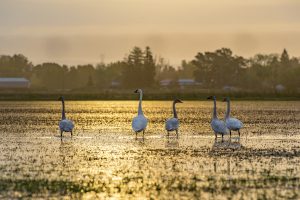By Katie Cahill, California Rice Commission
Watch Ricelands: Cultivating California’s Environmental Crop
An R. Michael Strategies production
Planted rice fields in the Sacramento Valley truly benefit many, from farming communities, to helping the Pacific Flyway flourish, to being studied by scientists to boost the salmon population for the future.
Ricelands: Cultivating California’s Environmental Crop details the history of the Sacramento Valley and highlights the innovative science taking place in rice fields.
 “We’re able to show the fish grow exceptionally well in these habitats. If they grow well, then they survive better out to the ocean, that translates into a population effect. So, we think if we do this the right way, and we do enough of these fields like this, we can boost the population.”
“We’re able to show the fish grow exceptionally well in these habitats. If they grow well, then they survive better out to the ocean, that translates into a population effect. So, we think if we do this the right way, and we do enough of these fields like this, we can boost the population.”
– Andrew Rypel, University of California, Davis professor in the Department of Wildlife, Fish and Conservation Biology
“The shallow environment here warms up a little bit and creates this massive food web, it’s this very productive environment. Once you get out in the river, there’s a lot less food. So, it seems like they’re happy to stay here and eat up.”
– Derrick Alcott, postdoctoral researcher studying juvenile chinook salmon as part of the California Ricelands Salmon Project in winter-flooded rice fields
“It’s not so much one field here, one field there that makes the impact. It’s the fact that we have hundreds of thousands of acres across the whole Sacramento Valley of rice growers who are willing to flood their fields and it can make a really dramatic impact for waterbirds and wildlife.”
– Kristin Sesser, waterbird ecologist and CRC Wildlife Programs Manager

“We’re capturing shorebirds and tagging them, capturing waterfowl and tagging them and also putting trackers in fish – all with the same objective, trying to understand how they use the rice landscape and how they interact with the other habitats around them and does it increase or decrease their survival. Largely, we’re seeing the ones that have access to the rice fields are doing better across the board.”
– Luke Matthews, managed CRC’s wildlife programs
“Rice is a great thing for many reasons. This is what’s unique to us in California, that environmental benefits side.”
– Charley Mathews, fifth-generation rice grower, Yuba County
“In the next generation we would love to see thriving rice farms, robust bird populations and healthy fish populations — and all of those three combined, that really is what a sustainable future looks like in the Sacramento Valley.”
– Elise Nelson, Sutter County rice growing family
To watch Ricelands: Cultivating California’s Environmental Crop, click here.
To learn more about the Ricelands Salmon Project, click here.
For more information on Floodplain Forward, see the booklet here.




